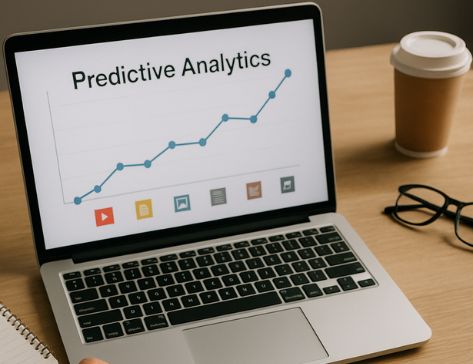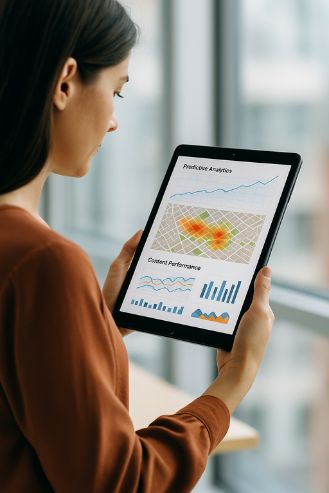
Predictive Analytics for Content Marketing: A Practical, Data-Driven Guide
Predictive analytics for content marketing is transforming how teams plan, create, distribute, and optimize every asset across the funnel.
As a discipline, it uses historical data and statistical or machine learning models to forecast the next best action—what topic to tackle, which format to invest in, when to publish, and how to personalize for each audience segment. For a primer that demystifies the core ideas, this predictive analytics overview is a helpful foundation before diving into marketing use cases.
Marketers often ask, “Where do we begin?” The short answer: start with questions tied to measurable outcomes (traffic growth, qualified leads, pipeline, retention) and back into the data you need. From there, build simple, interpretable models that make reliable, incremental improvements rather than chasing complexity for its own sake.
To operationalize this approach, most organizations benefit from a consolidated data layer that stitches together web analytics, CRM, marketing automation, and content performance data. A well-structured marketing data platform—complete with clear ownership, data contracts, and repeatable pipelines—makes it far easier to productionize predictions. If you’re designing your stack, this deep dive into marketing data platform architecture and a step‑by‑step playbook can guide your decisions.

How predictive analytics supercharges the content lifecycle
Think of the content lifecycle as a loop: research → ideation → creation → distribution → optimization. Predictive models can plug into each stage to reduce guesswork and magnify returns.
- Research: Topic demand forecasting estimates search volume and conversion propensity weeks or months ahead.
- Ideation: Clustering and topic modeling identify adjacent content opportunities and content gaps versus competitors.
- Creation: Readability and engagement models suggest the best depth, length, and structure for a given audience and intent.
- Distribution: Send‑time optimization and channel propensity models pick the right channel, day, and time for each segment.
- Optimization: Multi‑armed bandits continuously test titles, intros, CTAs, and images to lift engagement without endless A/B cycles.
Data sources that create predictive power
Great predictions come from clean, connected, and relevant data. You don’t need everything—just enough coverage and consistency to model your question.
- Web and product analytics: sessions, page depth, scroll, time on page, feature usage, activation milestones.
- Search data: rankings, impressions, click‑through rate, query intent, SERP features, seasonality patterns.
- CRM and MAP: lead source, lifecycle stage, campaign touches, MQL/SQL progression, revenue, churn signals.
- Content metadata: topic, format, word count, author, internal links, external links, freshness, structured data.
- Audience data: firmographics, technographics, industry, role, geo, account tier, consent preferences.
Models that work (without overcomplicating)
1) Forecasting content demand
Use time‑series models (e.g., Prophet, SARIMA) or gradient boosting regressors to forecast traffic and conversions for planned topics. Include covariates like seasonality, promotional calendar, and competitor activity. Evaluate with MAPE for traffic and MAE for conversion forecasts.
2) Propensity and uplift modeling
Classification models (logistic regression, XGBoost, LightGBM) estimate the probability that a reader will click, subscribe, or convert after engaging with a specific asset. Uplift modeling isolates the incremental effect of different treatments (e.g., CTA placement or offer type) on a segment.
3) Topic modeling and clustering
Apply NLP methods—TF‑IDF + K‑means, LDA, or embeddings with UMAP/HDBSCAN—to cluster pages and queries by intent. The output reveals content gaps and cannibalization risks, helping you consolidate overlapping posts and plan net‑new pillars and spokes.
4) Personalization and next‑best content
Recommendations can be as simple as co‑occurrence and item‑to‑item similarity using embeddings, or full collaborative filtering when you have enough user‑item interactions. Start small: “People who read X often read Y next.”
Predictive analytics for SEO impact
SEO thrives on forward‑looking decisions. Predictive models can prioritize which keywords to pursue by estimating the probability of ranking in the top 3, the expected time to rank, and the revenue potential if you win. Combine historical rank trajectories with page authority, competitive density, and SERP volatility to score opportunities. Then allocate production resources where expected impact is highest, not just where search volume looks big on paper.
Practical 90‑day implementation roadmap
- Weeks 1–2: Frame questions and metrics. Example: “Which upcoming topics will most likely generate MQLs within 30 days of publication?” Define success (lift in MQLs, assisted pipeline, velocity).
- Weeks 2–4: Data audit and stitching. Map sources to a unified schema. Establish IDs to join users, accounts, and content. Document data quality issues and quick fixes.
- Weeks 4–6: Baseline models. Build a simple propensity model and a demand forecast. Favor interpretability; ship something trustworthy.
- Weeks 6–8: Experiment design. Translate predictions into treatments (e.g., high‑propensity segments see long‑form guides with deep CTAs; others see lighter formats). Pre‑register success criteria.
- Weeks 8–12: Deploy and learn. Put models behind simple APIs or scheduled batch jobs. Automate a weekly performance review to decide what to scale, revise, or retire.
Measurement, attribution, and governance
Predictive systems are only as useful as the decisions they improve. Tie predictions to actions and evaluate the lift against a baseline. For attribution, combine position‑based or data‑driven models with post‑view/activity windows that reflect your buying cycle. Keep a model registry, version features, and track drift so you know when to retrain. Above all, respect privacy: implement consent management, minimize PII, and prefer aggregated or synthetic features where possible.
Common pitfalls (and how to avoid them)
- Vanity metrics fixation: Predicting pageviews is less valuable than predicting qualified engagement or revenue impact.
- Data leakage: Features that won’t be available at prediction time inflate model performance. Freeze feature windows carefully.
- Overfitting: Cross‑validate by time; keep a holdout period to simulate real‑world deployment.
- Black‑box bias: If marketers don’t trust the system, they won’t use it. Favor explainability tools like SHAP to surface drivers.
- One‑off projects: Treat predictive content ops as a product with an owner, backlog, and SLAs—not a series of disconnected analyses.
Example scenario: turning insight into action
Imagine a B2B SaaS team planning Q4 editorial. A demand forecast shows that “data governance checklist” queries spike in late October, while past behavior indicates that long‑form guides convert better for enterprise accounts. The team schedules a 2,000‑word pillar page for early October, supports it with checklists and a webinar invite, and configures a bandit to test three CTA variants. A propensity model targets enterprise and upper‑mid‑market accounts on LinkedIn and email with the pillar page, while SMBs receive a concise checklist variant. By mid‑November, the team sees stronger rank velocity, a 15% CTR lift on high‑intent queries, and a measurable uptick in qualified demo requests attributable to the sequence.
Team and process: who does what?
- Content lead: Owns editorial strategy and translates predictive insights into briefs and calendar decisions.
- Marketing ops/analytics: Manages data pipelines, model deployment, dashboards, and governance.
- SEO specialist: Partners on topic selection, internal linking, and technical signals that influence ranking probability.
- Channel owners: Execute distribution and measure treatment effects per segment and channel.
- Design and UX writing: Convert insights into scannable, accessible layouts that lift engagement.
Conclusion: turning predictions into predictable growth
With a lean stack, clean data, and a few well‑chosen models, predictive analytics for content marketing helps teams stop guessing and start compounding wins. As you scale, invest in modular data products, consistent taxonomies, and lightweight experimentation frameworks to keep learnings flowing back into planning and creation. And when competitive intelligence matters—especially for channel strategy and creatives—tools like Instream can reveal messaging trends and placements to inform your next round of tests. Ultimately, the goal isn’t to automate creativity; it’s to give your creators and channel owners the best shot at being right, more often, with less waste.


